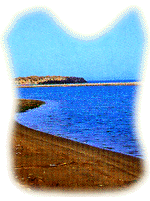 |


|
|
THE TERRITORY |
|
| The origins of the Etna massif date back some 600,000 years when enormous eruption covered the gulf with volcanic material from which the mountain was later to emerge: today it is the most important and most beautiful volcanic park in Europe. Defined by Pindaro as the "Column of the Sky", Etna's summit reaches 3,323 metres: over 2,000 metres naturalists place the only integral environment of the whole of Sicily where man is an extraneous or at most a transitory presence; porcupines, martens, foxes, red woodpeckers and Greek partridges, to name some of the inhabitants of the lower altitudes, live and reproduce here in an uncontaminated natural setting. Between 1,300 and 2,000 metres the chestnut trees give way to majestic beeches alongside birches and the only examples in Sicily of Calabrian larches, while on the slopes down towards the sea luxuriant fruit trees preceed vineyards, citrus and olive groves amidst a subtropical vegetation and the pines dotted along the Ionian coast. The Etna massif is bounded to the north by the Alcantara river, famous for the dramatic beauty of its gorges, and to the south by the Simeto which gives rise to the immense alluvial valleys and the fertile Catania plain; the river flows into the Ionian sea after crossing areas of marshland and sand dunes. The mouth of this river, known as the Simeto Oasis where the Gornalunga pond is also to be found, is one of the most interesting of the protected areas recently set up by the Province of Catania, along with those of Fiumefreddo, Timpa and the above-mentioned Etna park. As well as attracting lovers of nature, the four reserves are of great interest for students as they provide an outline of the province's natural and geological history. The Simeto Oasis is important from the ornithological point of view as it constitutes an optimal environment for many species of birds, including didappers, coots and plovers which nest in the ponds and marshes, in the river's offshoots among water lilies and tamarisks, and there are also many rare species of insects. The other two reserves have completely different characteristics, though they are equally interesting and impressive. The Timpa, formed by lava from Mount Etna and today covered by vegetation, is an impressive rocky cliff which rises coastline and then turns inland among the orange groves around Acireale, gradually rising in height. From Capo Mulini to Santa Maria La Scala it exceeds 100 metres at certain points, becoming a steep cliff precipitating down onto the sea, while elsewhere - along the beach at S. Tecla for example - it leaves a low, stony coast in front of it, formed by the offshoots of lava streams that have flowed down to the sea, widening the original shore. The Timpa is thus of great interest for volcanologists, being a natural geological fault arising from the central crater of Mount Etna to slope gradually down to the sea on the eastern side of the mountain. As far as the vegetation is concerned, the lava is covered with Mediterrranean bush and is rich in natural essences such as euphorbia, oleaster and laurel. The Fiumefreddo reserve deserves a description of its own. The river follows a short, winding course of just 1.5 km on the boundary between the boroughs of Caltabiano and Fiumefreddo, forming a little delta as it flows into the sea. Characterized by extremely cold and very pure water, the river is in some ways unique among Sicilian waterways. Its underwater vegetation is typical of Central European rivers with plants like Rammuculetum Fluitans (this is the furthest point south where it can be found). The riverside vegetation is also extremely rich with specimens of Cyperus Paprirus, American walnut and elegant black poplars. Trout live in its fresh waters and there are also two breeding grounds on the secondary course of the river where they can be fished for sport. If nature at times has had little pity for man here, attacking his civilisations with volcanic eruptions and earthquakes, at the same time it has been generous: the people of Etna have been nature's genial antagonists and the true protagonists of the territory's history. Ancient civilisations, preceeding the Greek and Roman settlements, have left their mark here, as we can see from the prehistoric remains, kept in the museum at Adrano. Such findings are evidence of an ancient Sicilian population which was socially and economically advanced, famous for its devotion to the god Palico or Adrano in whose honour a temple was built guarded by a thousand "cirnechi" (Sicilian dogs). Virgil mentions a young man, the son of Arcente, who was brought up in a wood close to the Simeto river where there was an altar dedicated to Palico - a further confirmation of the existence of the ancient city of Adranon. Since those distant times there has been a succession of civilisations which have left their mark on the territory, giving it its peculiar historic and artistic character. From the harsh and menacing architecture of the Medieval churches and castles to the unique baroque style of so many of the towns around Etna, from the suggestive countryside around Calatino to Caltagirone, city of sparkling majolica and Faenza of the South, it is not an exaggeration to state that the province is unique for the complexity and diversity of its styles and settings, matched together in perfect harmony.
|
||




